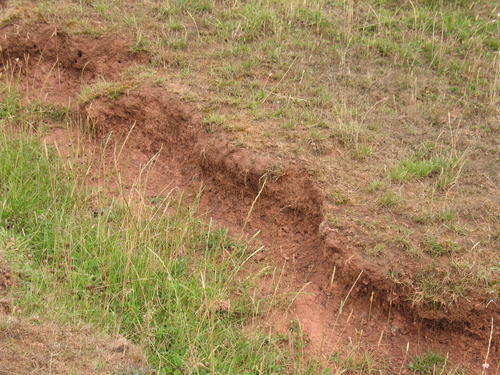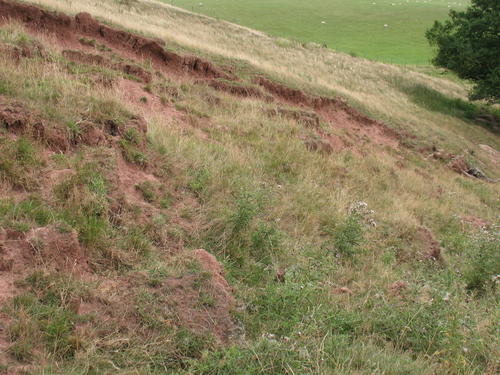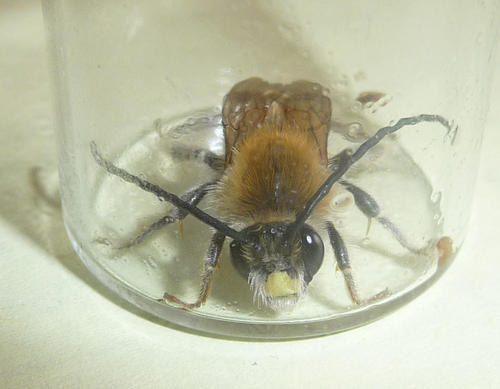In search of Eucera longicornis
Geoff Trevis
In 2007 a group from Worcestershire Recorders visited the old orchard at Joan’s Hole, near Heightington, a visit I was unable to attend. In the course of the day an unusual bee with immensely long antennae was noted foraging on yellow archangel Lamiastrum galeobdolon. This was photographed by Rosemary Winnall and later identified as Eucera longicornis. E. longicornis is a rare species of conservation concern and in 2009 I was invited by Hymettus Ltd. to revisit the site and undertake a study of the bee’s ecological requirements to assist in drawing up an action plan. Unfortunately, in the time between the original record and the proposed study the orchard had been acquired by a new owner and tidied up. This was in the interests of managing the orchard but, unfortunately, virtually all the yellow archangel had been removed and despite several visits during the expected flight period of E. longicornis there was no sign of the bee.
The initial visits to the orchard were made along the Dick Brook, mainly through woodland, and the total list of hymenoptera records was very short. However, the search area was widened later to encompass fields belonging to the nearby Norchard Farm, Old House Farm and Chapel Farm. At this stage I would like to acknowledge the assistance given by Rosemary Winnall both in helping with the recording and with contacting the land owners for permission to access their land. The outcome of extending the survey area was both unexpected and very pleasing.
On Norchard farm, close to the public footpath, a meadow is maintained for hay for winter feed for horses. This field had an abundant flora ranging from Red Clover Trifolium pratense to a thriving population of Common Spotted Orchids Dactylorhiza fuchsii and round its perimeter brambles, hawthorn and other shrubs added to its diversity. It seemed particularly attractive to bumblebees though other mining bee species were present and, no doubt, their cleptoparasites would also have been found if more time had been given to collecting there.
The first big surprise came on Old House Farm (Fig. 1.). The Worcestershire Way goes through the orchard and then enters Old House Farm via a bridge over the Dick Brook. Within a few yards of the bridge and right by the Worcestershire Way there was a low, vertical bank about 10 cm high and a couple of metres long, probably the remains of the track of a wheeled vehicle. The field itself was unimproved with Red Clover, Bird’s-foot Trefoil Lotus corniculatus, various thistles and vetches, Common Ragwort Senecio jacobaea, Common Spotted Orchid plus much more. The bank was alive with bees, mining bees, potter wasps, cleptoparasites and solitary bees, sustained by the rich nearby flora and the excellent nesting site. Further investigation on Old House Farm, approaching from the farm house and yard, showed that most of the land is on steep hillsides used for sheep grazing where land slips maintain ideal mining bee nesting sites. The farm itself was being developed as a rare breed and wildlife centre and hence the land remained unimproved. Unfortunately, the weather in 2011 was rather against us and there was little addition to the species recorded which are: Grey Mining Bee Andrena cineraria, Yellow-legged Mining Bee Andrena flavipes, Andrena fucata, Early Mining Bee Andrena haemorrhoa, Andrena nitida, Andrena labialis, Andrena wilkella, Red-tailed Bumblebee Bombus lapidarius, Early Bumblebee Bombus pratorum, Common Carder Bee Bombus pascuorum, Buff-tailed Bumblebee Bombus terrestris, Ornate tailed digger wasp Cerceris rybyensis, the Sleepy Carpenter bee Chelostoma florisomne, a cuckoo wasp Chrysis viridula, a digger wasp Crossocerus ovalis, 4-spotted Digger Wasp Crossocerus quadrimaculatus, an ant Formica fusca, 4-banded Digger Wasp Gorytes quadrifasciatus, Halictus rubicundus, Lasioglossum malachurum, Lasioglossum morio, an ant Lasius niger, a nomad bee Nomada flava, a nomad bee Nomada flavoguttata, a nomad bee Nomada fucata, Spiny Mason Wasp Odynerus spinipes, a cuckoo wasp Pseudospinolia neglecta, and a cuckoo bee Sphecodes rubicundus. The findings here, especially in the area surrounding the wheel track, underline the need to be aware of small scale features in the landscape which may be vitally important for invertebrates.
Chapel Farm presented a slightly different situation. Whilst still on steep hillsides grazed by sheep it had not been managed as a conservation area and was, therefore, not as floristically rich. However, extensive land slip provided large areas suitable for mining bee nests (Fig. 2.). Fewer species of hymenoptera were found here but continued monitoring of the land slips through the seasons would be fully justified. The species list is Bombus lapidarius, Bombus pascuorum, Bombus terrestris, Andrena cineraria, Andrena scotica, Crossocerus quadrimaculatus, the tree wasp Dolichovespula sylvestris, Formica fusca, Lasioglossum calceatum, Myrmica rubra, Nomada fucata, Nomada ruficornis, Sphecodes rubicundus and Sphecodes puncticeps. The presence of several cuckoo species suggests that more of their target species should be present, for example Andrena flavipes whose nests are targeted by Nomada fucata; Andrena haemorrhoa the target for Nomada ruficornis; Andrena labialis which is targeted by Sphecodes rubicundus; and other Lasioglossum species attacked by Sphecodes puncticeps.
Joan’s Hole and its approaches are once again a different habitat with considerably more tree cover and a different flora for hymenoptera foraging. The species encountered were Andrena cineraria, Andrena haemorrhoa, Andrena scotica, Andrean synadelpha, Andrena wilkella, Athalia circularis (a sawfly), Bombus lucorum, Bombus lapidarius, Bombus pascuorum, Bombus pratorum, Bombus terrestris, Bombus vestalis (a cuckoo species), Lasioglossum albipes, Lasius brunneus, Lasius flavus, Lasius niger, Myrmica ruginodis, Nomada flava, Nomada flavoguttata, Nomada fucata, Nomada lathburiana, Nomada ruficornis, Odynerus spinipes, red mason bee Osmia rufa, Priocnemis susterai (a spider-hunter wasp), Pseudospinolia susterai, and Sphecodes rubicundus.
You will no doubt notice that Eucera longicornis is absent from the lists despite the title of the report being “In search of Eucera longicornis”. Unfortunately, systematic searching for two years has failed to find any trace of this species and one must regretfully conclude that it is now extinct in the area. The only record in 2011 was a single male seen and photographed by Harry Green in the car park at Knighton-on-Teme village hall. Further searches in the Knighton-on-Teme area were negative so that continuing the proposed ecological investigations is not recommended. It seems likely the E. longicornis can maintain a population over a wide area at very low population density and may thus be difficult to find (Mike Edwards, personal communication).
In addition to Rosemary Winnall I would like to record my thanks to Harry Green and Nigel Jones for their help with the survey, to Mr. Peter May for permission to collect on Old House Farm and to Mr.& Mrs. C. Pratt for permission to collect on Chapel Farm.
Images
Fig. 1. Oldhouse Farm small bank colonised by Hymenoptera. Geoff Trevis.
Fig. 2. Bank at Chapel Farm showing landslips colonised by Hymenoptera. Geoff Trevis.
Fig. 3. Eucera longicornis Knighton on Teme 19th May 2011. Harry Green.


